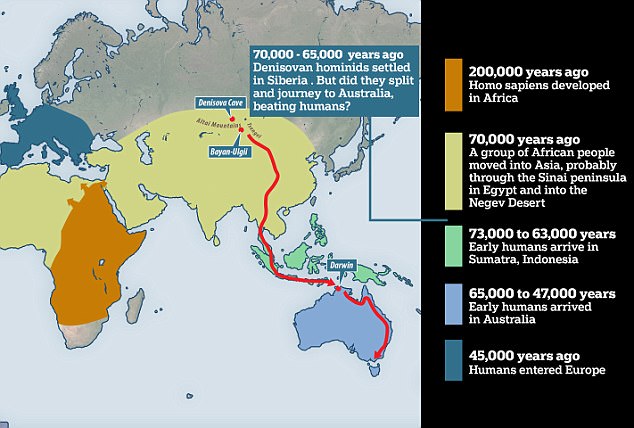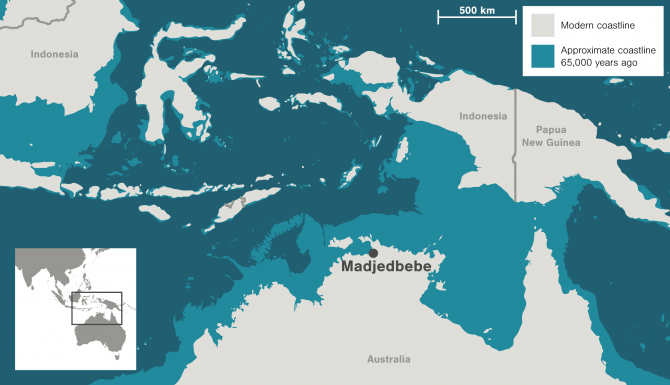Robert sent in this link – go to www.dailymail.co.uk/sciencetech/article-4883302/DNA-rewrite-story-Austra… …. where we have the idea that Australian Aborigines are descendants of Denisovans. I can't see anything particularly controversial about this as Europeans are thought to be descended from Neanderthals (who were contemporaries of the Denisovans). In both cases there is around 4 per cent of Denisova or Neanderthal DNA in modern populations – the rest of it has probably been diluted due to bottlenecks and mass die-offs during catastrophic events in the past. However, the idea is controversial it seems and this article is splendid as it gives one side of the story, an Australian scientist that took part in excavations at the Denisova cave in what is now Russia (see maps below) and then provides plenty of contrary views including those of Chris Stringer from the Natural History Museum in London. The Daily Mail noticeably differs to the Guardian and Independent way of dealing with archaeology and human origins, and always has plenty of pictures to go with the text.
Denisovans are known from a cave in the Altai Mountains in central Asia – over 5000 miles from Australia. The theory suggests that some big migrations took place in the deep past – but why not …

 … Denisova DNA turns up in populations in SE Asia, Indonesia, the Solomon Islands and Melanesia in general, New Guinea and Australia. The above image is the current (recently updated) timeline of human spread Out of Africa in these regions and put simply are just guesswork. Each new find pushes the dates backwards. We don't know when people reached Australia. The timeline has been adjusted, re-adjusted, and no doubt will be adjusted at some point in the future. Apparently we now have evidence of modern humans in China 80,000 years ago – and in Sumatra 65,000 years ago (roughly at the time humans were in Australia). It seems that Tibetans have also inherited Denisova traits, the ability to live at high altitude. Researchers find human movement at this stage difficult to square with the geography – and the existence of large bodies of water separating the different groups. This is because all things catastrophist are absent from their thinking and models. Changes in the Earth's geoid as a result of axial changes could have realigned the sea levels quite dramatically. We know that Sunda Land existed prior to 8000 years ago, dry land between Malaya and most of Indonesia, but what was it like at 100,000 years ago – or longer. Do we know? Looking at human origins without taking into account catastrophism is inhibiting. Once geographical change is taken into account many other things fall into place – and promising theories can be explored (even by computer simulation).
… Denisova DNA turns up in populations in SE Asia, Indonesia, the Solomon Islands and Melanesia in general, New Guinea and Australia. The above image is the current (recently updated) timeline of human spread Out of Africa in these regions and put simply are just guesswork. Each new find pushes the dates backwards. We don't know when people reached Australia. The timeline has been adjusted, re-adjusted, and no doubt will be adjusted at some point in the future. Apparently we now have evidence of modern humans in China 80,000 years ago – and in Sumatra 65,000 years ago (roughly at the time humans were in Australia). It seems that Tibetans have also inherited Denisova traits, the ability to live at high altitude. Researchers find human movement at this stage difficult to square with the geography – and the existence of large bodies of water separating the different groups. This is because all things catastrophist are absent from their thinking and models. Changes in the Earth's geoid as a result of axial changes could have realigned the sea levels quite dramatically. We know that Sunda Land existed prior to 8000 years ago, dry land between Malaya and most of Indonesia, but what was it like at 100,000 years ago – or longer. Do we know? Looking at human origins without taking into account catastrophism is inhibiting. Once geographical change is taken into account many other things fall into place – and promising theories can be explored (even by computer simulation).
